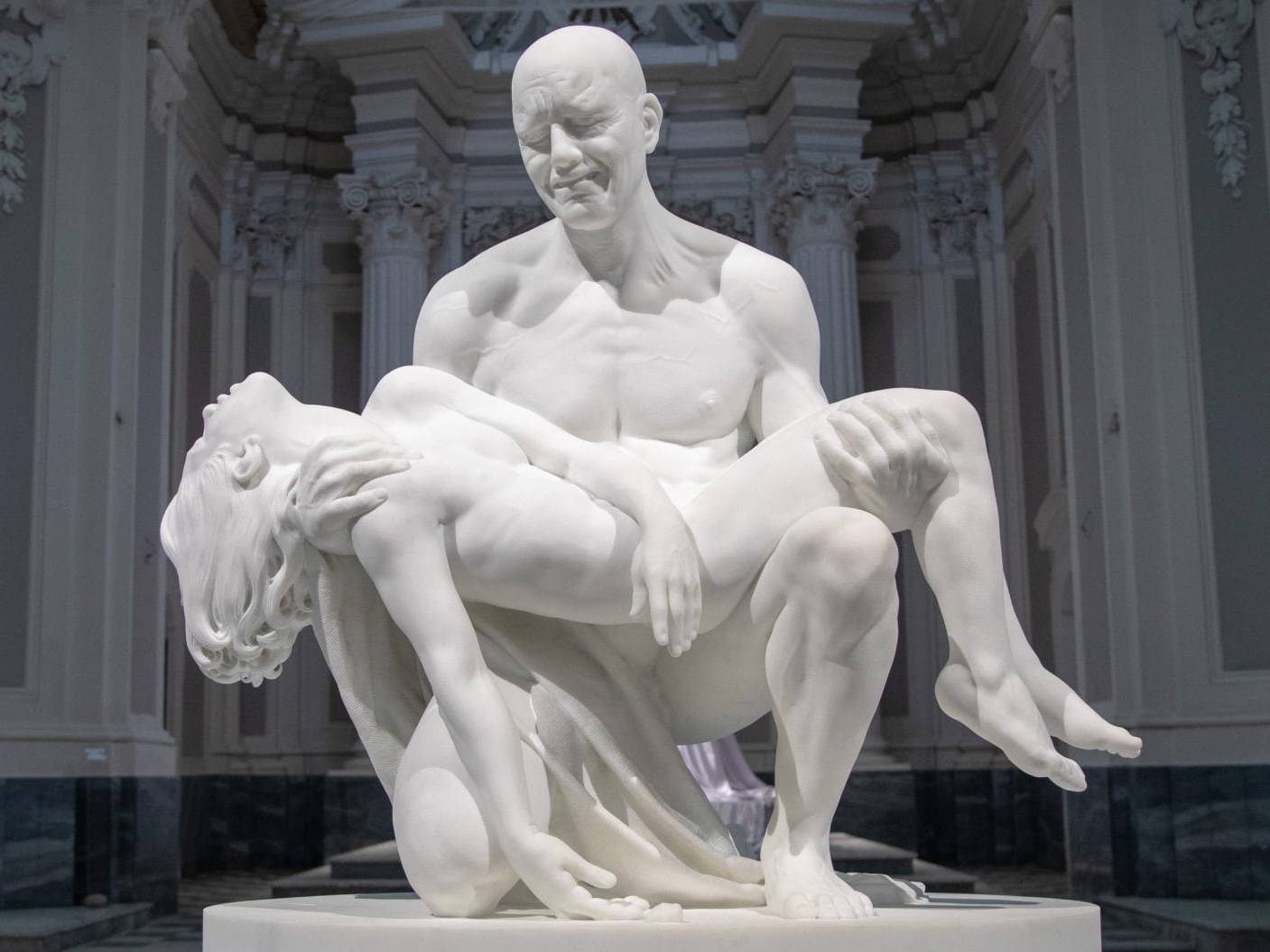
 We the Italians Editorial Staff
We the Italians Editorial Staff
Italian art: Jago, the Italian sculptor who became a gallery of his own
- WTI Magazine #183 Jan 11, 2025
-

 We the Italians Editorial Staff
We the Italians Editorial Staff
Jago, an Italian sculptor whose real name is Jacopo Cardillo, has quickly become a prominent figure in the contemporary art world. His unique approach to sculpture and his introspective philosophy have established him as an artist who bridges the traditional and modern, offering new interpretations of classical art forms while addressing current cultural issues.
In a world where art often seems detached from human experience, Jago’s work stands as a testimony to the power of human connection, emotion, and identity.
A Journey of Self-Discovery and Artistic Evolution
Jago’s career can be traced back to his early days in Naples, where he began developing his passion for sculpture. As a child, he was fascinated by the human form, and this interest eventually led him to study sculpture formally. Over time, his exploration of classical techniques combined with his deep philosophical reflections on life, death, and human experience began to define his artistic style.
One of the core ideas Jago explores in his work is the human condition. His sculptures often depict figures caught in moments of emotional vulnerability, whether in states of anguish, ecstasy, or contemplation. The human body, with its expressive potential, remains at the center of Jago's artistic exploration, and his skill in rendering anatomy with extraordinary realism allows him to capture the subtle nuances of emotion and psychological depth.
A key turning point in Jago’s artistic career was his decision to focus on creating works that didn’t just exist within the confines of galleries or museums but were instead a form of public art, meant to engage a wider audience. His work can be seen as a statement of resistance against the commercialization of contemporary art and the tendency of galleries to turn art into a commodity. By bringing art into the streets and public spaces, Jago makes his sculptures accessible and ensures that they provoke conversation and reflection among a broad spectrum of people.
Merging the Traditional with the Contemporary
Although his works are undeniably rooted in the classical tradition, Jago is a progressive artist who continually challenges the boundaries of what sculpture can achieve. His mastery of traditional techniques such as marble carving and bronze casting enables him to produce hyper-realistic, emotionally charged sculptures that seem to breathe with life. Yet, he often incorporates modern technologies into his artistic process, particularly 3D scanning and digital modeling, to create pieces that blur the lines between traditional craftsmanship and contemporary innovation.
In one of his most famous works, The Veil, Jago showcases his extraordinary ability to bring marble to life. The sculpture depicts a figure partially covered by a veil, which is rendered with such delicate precision that it seems almost ethereal. The veil itself is not just a physical object but also symbolizes the complexities and fragility of human existence. By making the marble appear so light and translucent, Jago challenges the idea that sculpture must always be heavy or rigid, offering instead a more dynamic interpretation of form.
Jago’s use of modern technology in sculpture is another distinguishing feature of his work. He has embraced tools like 3D printing to aid in the creation of prototypes and experimental pieces, allowing him to push the boundaries of what can be achieved with traditional materials. These hybrid works, in which the classical meets the contemporary, are a reflection of Jago’s personal evolution as an artist and his response to the ever-changing landscape of the art world.
Art as a Mirror of Society
Beyond the technical aspects of his sculptures, Jago is deeply concerned with the societal and cultural context in which his art exists. In a world where art is often consumed as a commodity or used for marketing and branding purposes, Jago seeks to create works that challenge viewers to think critically about their own lives, values, and emotions.
His works often address the theme of human vulnerability, whether it is the fragility of the body or the emotional complexity of the human spirit. For instance, in Self Portrait in Marble, Jago presents a sculpture that merges the artist’s own face with the texture of the marble, creating an intimate, reflective work. This piece is not only a self-portrait but also a commentary on the ways in which artists, particularly in the age of social media, are constantly scrutinized, commodified, and expected to present an idealized version of themselves.
Moreover, Jago's art is often seen as a critique of the art world itself. He has openly discussed his discomfort with the contemporary art market, where artists can sometimes feel pressured to produce works that are commercialized or trend-driven rather than inspired by genuine creative impulses. In this sense, Jago’s sculptures can be viewed as acts of resistance—works that are not just for the sake of aesthetics or commercial success, but for their ability to provoke thought and elicit deep emotional responses.
Jago in the U.S.
Between 2018 and 2020, during his time in New York, Jago created three works using Vermont marble, which in the past was used by the many Italians who emigrated to the Green Mountain State remembered especially in the town of Barre. The three works are Look Down, The First Baby, and The Veiled Son. In 2024 Look Down which was born from the observation of numerous homeless people sleeping on the streets, returned to New York. Vandalized first in Naples and then in the Middle East, Look Down was also vandalized in New York: an inscription “Supreme” on her forearm, a scar on her head, pebbles taken from the park and stuck inside her nose. But the artist has always accepted these acts of vandalism as contributions to the life of his work and the thought it is meant to provoke.
A New Vision for the Art World
Jago’s approach to art is not simply about making a statement—it is about reimagining the role of the artist in society. Unlike many contemporary artists who may choose to distance themselves from the public, Jago is deeply involved in the process of presenting and interpreting his work. He often engages with his audience directly through social media, where he shares behind-the-scenes glimpses of his creative process and interacts with his followers. This engagement creates a sense of transparency and accessibility, allowing people to connect with the artist on a personal level.
In this way, Jago becomes a gallery of his own, offering viewers not just his sculptures but an inside look into his thoughts, philosophy, and process. His work, in this sense, goes beyond the static nature of traditional art exhibitions. It invites participation, dialogue, and ongoing reflection.
Jago’s rise as a contemporary sculptor represents a refreshing return to classical techniques while embracing the possibilities of modern technology. His work is a deep exploration of the human form, both in its physicality and its emotional complexity. His sculptures challenge our perceptions of vulnerability, identity, and the role of art in society. By pushing the boundaries of traditional sculpture and engaging directly with his audience, Jago has created a unique niche for himself in the contemporary art world.